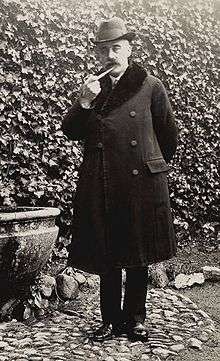Charles Du Bos

Charles Du Bos (known as Charlie to his friends)[1] was a French essayist and critic . He was born 27 October 1882 in Paris and died 5 August 1939 at La Celle-Saint-Cloud, where he is buried.
Life
Charles Du Bos was the first child of a family moving in the highest Parisian society. His father was the diplomat Auguste Du Bos, Knight of the Legion of Honour and a friend of the Prince of Wales. His mother, Mary Johnston, was English and brought up her son with a fluent command of her language. He was schooled at the Lycée Janson de Sailly and later spent a year at Balliol College, Oxford. In 1907 he married Juliette (Zézette) Siry, by whom he had one daughter, Primerose.
Having initially studied art history, he turned his interest to literature and was friendly with many of the leading writers of the time, not simply in France but abroad as well. In 1908 his translation of Edith Wharton’s novel The House of Mirth was published. Then at the outbreak of World War 1 he worked with her in founding the Foyer Franco Belge to help refugees from the occupied areas.[2] It was during this time too that he worked with André Gide, with whom he began a close friendship until they eventually fell out after the publication of Du Bos’ Le dialogue avec André Gide (1929).
As a member of the circle about Maria van Rysselberghe (wife of the painter Théo van Rysselberghe), he had been among those who planned the Nouvelle Revue Française (NRF), for which he wrote frequently.[3] Following years of agnosticism and then conversion to Catholicism in 1927, he became editor of Jacques Maritain’s review, Vigile (1930-33), to which NRF’s Catholic authors had defected.[4] In this appeared his essays “The Spiritual in Literature” and “François Mauriac and the problem of the Catholic novelist”, which are indicative of his moral preoccupations. As an Anglophile, he also featured English Catholic poets in the review, including Coventry Patmore, Maurice Baring, G.K. Chesterton and Fredegond Shove.[5]
The range of those about whom Du Bos wrote was wide and included English, German and Russian writers as well as French. For the most part it was in essays that were collected in several volumes under the title Approximations (1922-37). His book Byron et le besoin de la fatalité (1929) was published as Byron and the Need of Fatality in 1932. After teaching at St Mary’s College, University of Notre Dame during 1937-8, his lectures on Shelley and Keats were published as What Is Literature in 1940. Mostly he was noted for his interest in the inward qualities of literature and its reception, about which he wrote in the private journals he kept from 1908 onwards. Although extracts from these were published in 1931, the bulk of them were only published in installments after his death.
Publications
- Réflexions sur Mérimée. Albert Messein, 1920.
- Approximations. Série I (1922), série II (1927), série III (1929), série IV (1930), série V (1932), série VI (1934), série VII (1937) - New edition Éditions des Syrtes, 2000. 1525 pp.
- Le dialogue avec André Gide. Éditions Au Sans-Pareil, Paris, 1929. New edition Éditions Corréa, 1946.
- Byron et le besoin de la fatalité. Éditions Au Sans-Pareil, Paris, 1929. New editions Éditions Buchet-Castel, 1957, Archives Karéline, 2009.
- Extraits d'un Journal (1908-1928). Éditions Corréa, 1931.
- François Mauriac et le problème du romancier catholique. Éditions Corréa, 1933.
- What Is Literature?. Sheed & Ward, 1940.
- Grandeur et misère de Benjamin Constant. Éditions Corréa, 1946.
- La Comtesse de Noailles et le climat du génie. Éditions La Table Ronde, 1949.
- Journal (1921-1923). Éditions Corréa, 1946. New edition, Journal 1920-1925, Éditions Buchet-Chastel, 2003. 1069 pp.
- Journal (1924-1925). Éditions Corréa, 1948.
- Journal (1926-1927). Éditions Corréa, 1949. New edition, Journal 1926-1929, Éditions Buchet-Chastel, 2004. 999 pp.
- Journal (1928). Éditions Corréa, 1950.
- Journal (1929). Éditions Corréa, 1954.
- Journal (Janvier 1930 - Juillet 1931). La Colombe, Éditions du Vieux Colombier, 1955. New edition, Journal 1930-1939. Éditions Buchet-Chastel, 2005. 1054 pp.
- Journal (Août 1931 - Octobre 1932). La Colombe, Éditions du Vieux Colombier, 1955.
- Journal (1933). La Colombe, Éditions Du Vieux Colombier, 1959.
- Journal (Avril 1934 - Février 1939). La Colombe, Éditions du Vieux Colombier, 1961.
References
- This article is dependent on those on Charles Du Bos in the French Wikipedia and Spanish Wikipedia
- ↑ Clara Debard, "L’Échange épistolaire : Charles Du Bos et André Gide", Litterature 141 (2006), pp.55-67
- ↑ Alan Price, The End of the Age of Innocence: Edith Wharton and the First World War, New York 1996, pp.28-9
- ↑ Babelio
- ↑ Michael Einfalt, ”Jacques Maritain versus André Gide” in The Maritain Factor: Taking Religion Into Interwar Modernism, Leuven University 2010, p.159
- ↑ Contents, "Vigile 1930-33"